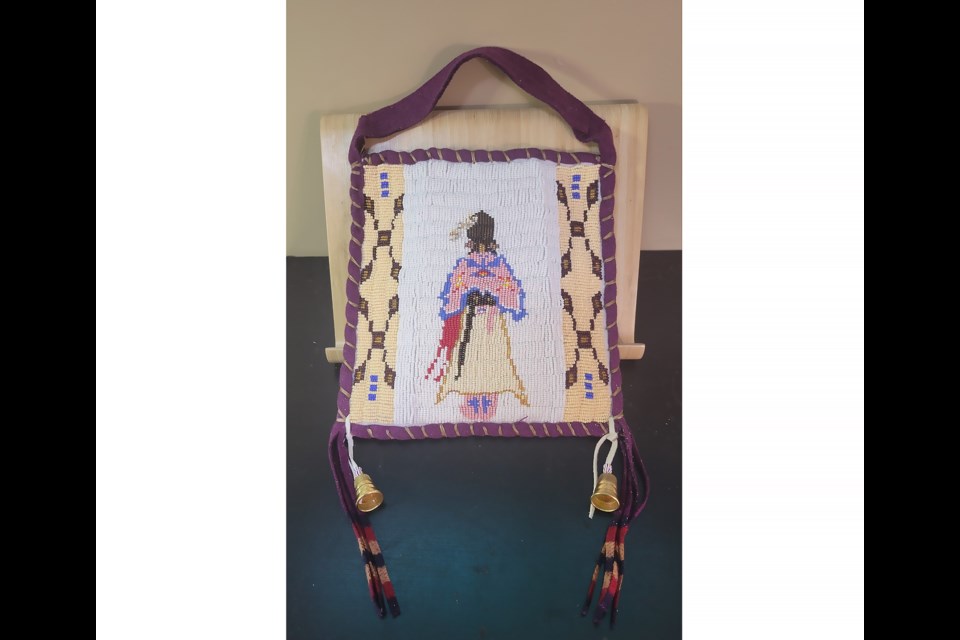CANMORE – Every interconnected stitch, every bead, forms a story.
More than countless hours of skilled handiwork, for Teresa Snow designing regalia is a journey – a story in itself. Some journeys take years to complete to gather all the right materials, with the right intent.
“We tell our stories through beadwork, unlike a book … we do it through beadwork or the sewing that we do,” said Snow, of Goodstoney First Nation. “We don’t necessarily have a written tradition, so it’s often through art that we tell our stories.”
Wagaichibi Îhnuthe: The Dance Regalia of the Îyârhe (Stoney) Nakoda at the Canmore Museum, celebrates the First Nations’ connection to powwow and traditional regalia worn by Goodstoney, Chiniki and Bearspaw dancers through various pieces of regalia created primarily by Snow, as well as her nephew, Eli Snow.
Snow learned to bead from family members, mentors and other relatives, with a healthy dose of experimentation along the way.
“Cultural significance and spirituality, that’s interconnected in beadwork. So, it can take a long time to source these items to make a piece of regalia,” said Snow, who has created over 20 pieces of regalia in her 50-year lifetime.
Perhaps the most crucial item of all is energy.
“A lot of energy goes into these pieces,” she said. “One outfit took about five years to get all the pieces at different times because of work, school, family, and just being in that right place to make those things.”
The Canmore Museum exhibit follows the Îyârhe Nakoda’s cultural journey through regalia. The journey spans from the earliest recorded powwow performances for non-Indigenous peoples at the Banff Springs Hotel in 1894 to the present-day competitive powwows in Mînî Thnî (Morley) and Eden Valley.
Before the Îyârhe Nakoda were contacted by early settlers and before they practiced beadwork, quillwork was prevalent in different styles of Stoney dance regalia and clothing.
“I show different styles of quillwork that I do that is more pre-contact times and I think that awareness aspect is important for people – to understand we’re more than beads and feathers,” said Snow. “Beads came here by way of Europe and were traded at trading posts with First Nations.
“We traded with them and we used those materials because we were segregated to reserves. We couldn’t hunt and we couldn’t get quills.”
Some of the regalia and other items on display at the museum are from Snow’s personal collection of work and others were made special for the exhibit.
One of the artist's women’s fancy regalia pieces depicts her personal healing journey.
“In it, you’ll see the beadwork and horses highlighted in it as like a spiritual, personal journey for me in sharing that with others,” said Snow.
“It’s a way of healing because powwow dances uplift and heal.”
It was important to Snow to include different styles of regalia used in powwow, such as traditional and women’s fancy.
A staple in Îyârhe Nakoda powwow culture, particularly in women’s dancing, is the high-top – footwear with a moccasin-like bottom, traditionally using beadwork and made with tanned hide or buckskin that wraps around the leg to hold the footwear in place. It’s incorporated as part of the regalia to keep dancers “grounded to tradition and lineage,” said Snow, and she expects she’d be called out for not including at least one pair.
“I always remember my mom having a pair. I had a pair when I first started dancing and I made a pair for my oldest daughter when she was little,” she said. “It’s just something that’s passed on and we’re known for.”
Linda Whittaker, interim excutive officer at the Canmore Museum, said the exhibit, which opens Thursday (Sept. 21), is part of the organization’s efforts to create a more social museum, with more interaction with the community and rotating displays to better tell the stories of people in the Bow Valley.
“We recognize that our Stoney Nakoda neighbours are particularly excluded from a number of previous actions and so we wanted to take an opportunity to start to bridge that gap,” she said.
“To do an exhibition about powwow and dance from Stoney Nakoda artists and our stories and our way of doing things, it keeps in line with TRC (Truth and Reconciliation Commission) and bridging gaps, awareness and learning,” said Snow.
The show opened with a ceremony Sept. 21 and will run until Jan. 18, 2024 at the Canmore Museum.
The Local Journalism Initiative is funded by the Government of Canada. The position covers Îyârhe (Stoney) Nakoda First Nation and Kananaskis Country.




